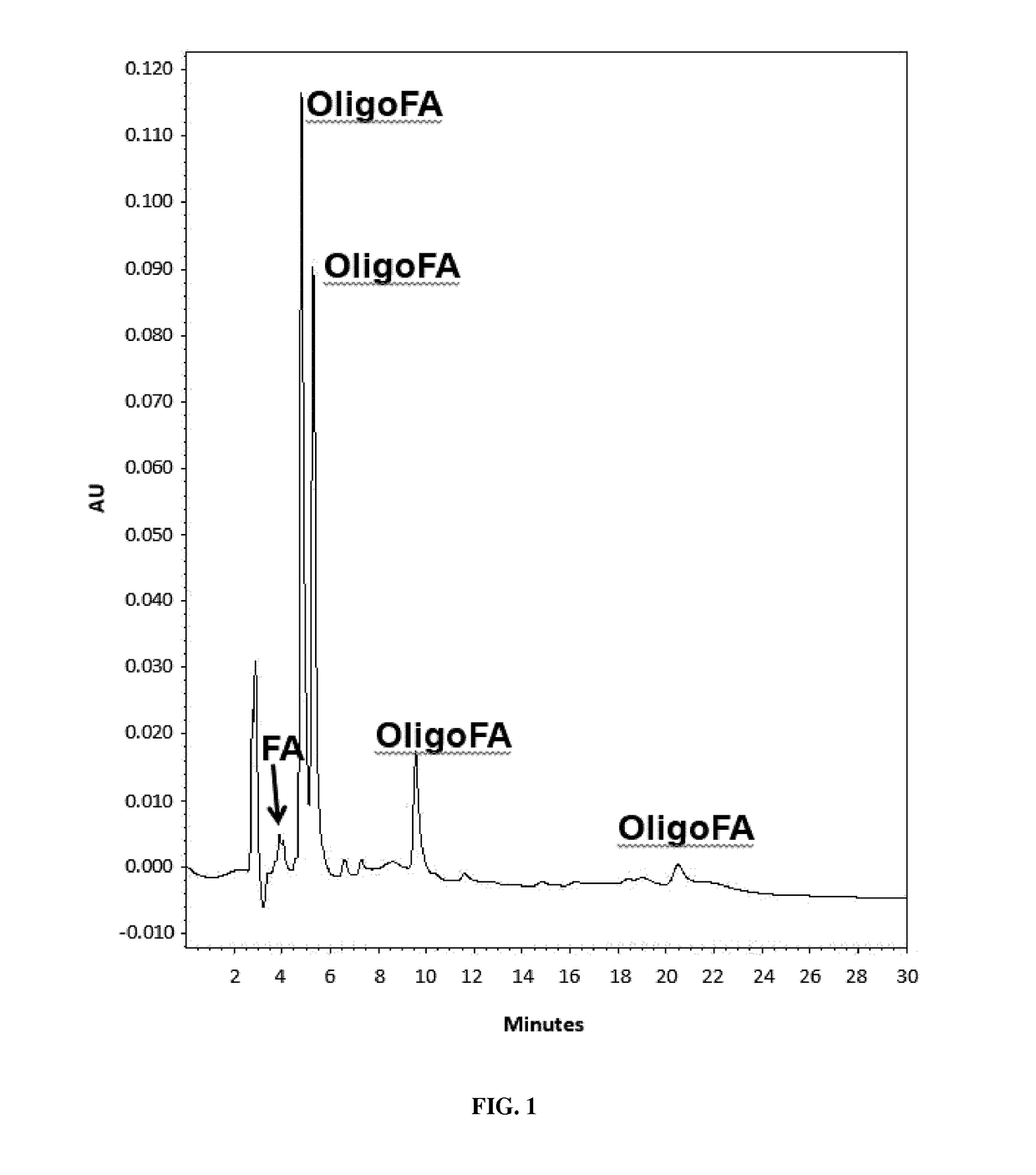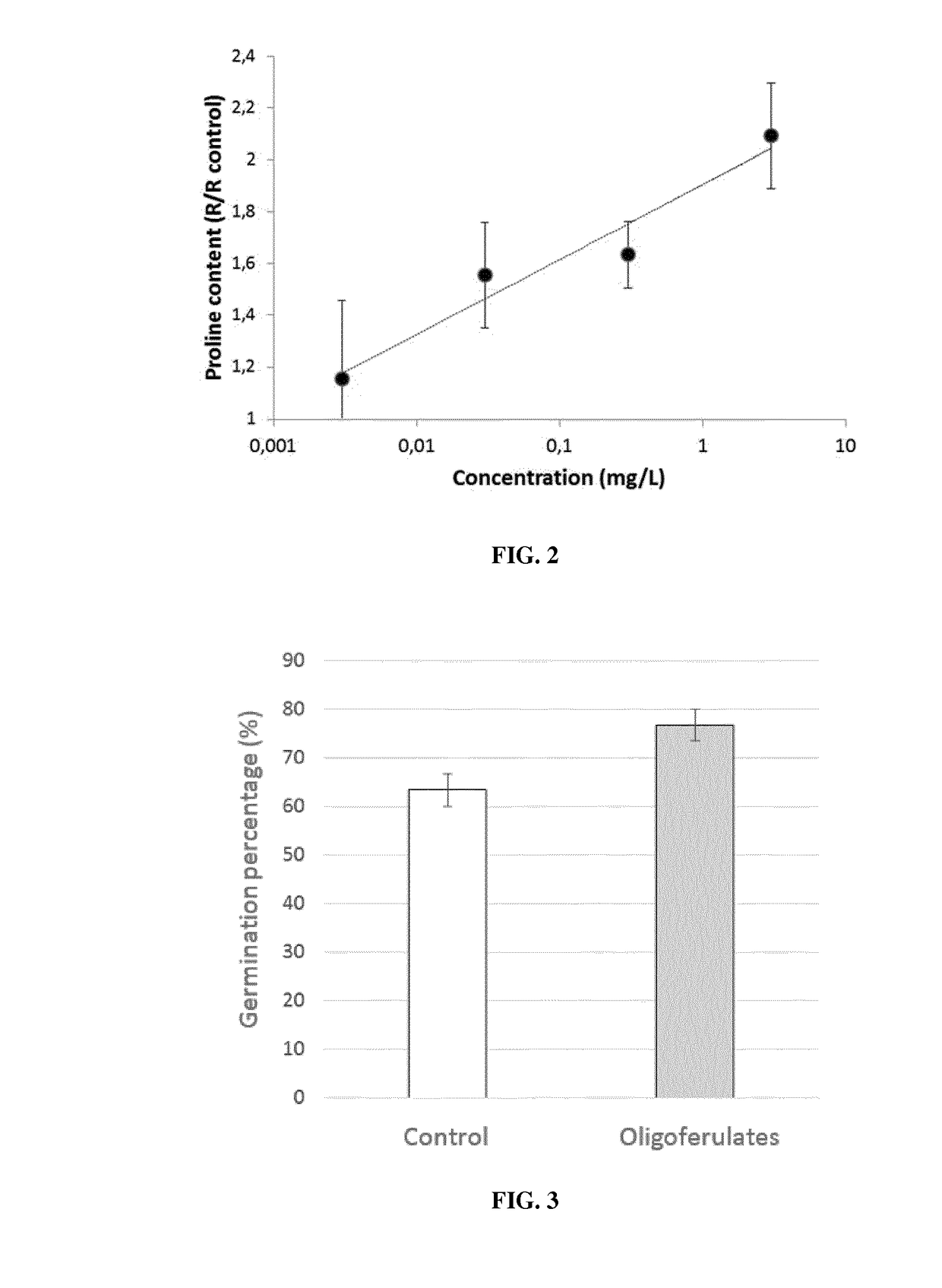Bioactive composition for improving stress tolerance of plants
a bioactive composition and plant technology, applied in the field of plant stress tolerance improvement, can solve the problems of serious damage to consumer health and negative impact on crop production, and achieve the effect of improving plant resistance and confirming the beneficial effect of proline overproduction
- Summary
- Abstract
- Description
- Claims
- Application Information
AI Technical Summary
Benefits of technology
Problems solved by technology
Method used
Image
Examples
example 1
on of Oligomers of Ferulic Acid Using a Laccase as Enzyme
[0167]A solution of 5 mM ferulic acid in methanol (50 mL) was added to 180 mL of ethyl acetate. After mixing, 200 mL of solution of laccase 1 U / mL (Sigma-38429, Laccase from Trametes versicolor) in 50 mM sodium acetate buffer (pH 5.0) was added, and the reaction carried out at 25° C. for 24 hours by shaking on an orbital shaker at 150 rpm. Upon termination of reaction, the organic phase was separated using a separation funnel and the aqueous phase washed twice with ethyl acetate. All ethyl acetate extracts were evaporated under reduced pressure using a rotary evaporator.
[0168]RP-HPLC analysis was carried out using a Waters Symmetry C-18 column (46×250 mm) in a Waters Alliance separation module 2695 coupled with a Waters UV detector at 320 nm. The mobile phase consisted of acetonitrile / 1% acetic acid (30:70) mixture and the flow rate was 1 mL / min and separation was carry out at room temperature. Before injection, s...
example 2
on of Oligomers of Ferulic Acid Using a Peroxidase as Enzyme
[0173]A solution of 50 mM ferulic acid in methanol (200 mL) was added to a mix of 400 mL of methanol, 80 mL of hydrogen peroxide 0.3% and 600 mL of 50 mM phosphate buffer (pH 7.0). After mixing, 10 mL of solution of 1% horseradish peroxidase (245.7 U / mg, AMRESCO INC) in 50 mM phosphate buffer (pH 7.0) was added and the reaction carried out at 25° C. for 24 hours by shaking on an orbital shaker at 150 rpm. Upon termination of reaction, the reaction mixture was filtered and the precipitate washed twice with methanol. The methanol filtrate and the soluble phase of the reaction were evaporated under reduced pressure using a rotary evaporator.
[0174]The reaction products were re-dissolved in methanol and a TLC analysis was performed on silica gel plates (MERCK 60. GF-254) using benzene:dioxane:acetic acid (25:7:1, v / v / v) as the mobile phase. In addition, a RP-HPLC analysis was carried out using a Waters Symmetry C-18 column (46×2...
example 3
raying of Diferulate Oligomers Increase Proline Content in Tomato Plants in a Dose-Response Pattern
Materials and Methods
[0175]Tomato plants of the variety “moneymaker” were growth for 3 weeks on soil under controlled conditions (light / dark regime of 16 h / 8 h respectively, at 24° C.). Formulations containing diferulate at increased concentrations, and Tween 80 (Polysorbate 80) at 0.01% as emulsifier were sprayed on the tomato leaves till run off. A solution of Tween 80 at 0.01% was used as control. After 24 hours, the true leaves from plants treated by spraying were collected and ground in liquid nitrogen.
[0176]Proline (Pro) was estimated in tomato leaves according to Bates et al. (Plant and Soil. 1973, 39:205-207) based on proline's reaction with ninhydrin. A 500 mg fresh leaf samples were homogenized in 5 mL of 3% aqueous sulphosalycylic acid and centrifuged at 22000 g for 5 min. The supernatant was filtered through Sartorious filters (0.45 μm). To 1 mL of the filtrate, 1 mL of nin...
PUM
 Login to View More
Login to View More Abstract
Description
Claims
Application Information
 Login to View More
Login to View More - R&D
- Intellectual Property
- Life Sciences
- Materials
- Tech Scout
- Unparalleled Data Quality
- Higher Quality Content
- 60% Fewer Hallucinations
Browse by: Latest US Patents, China's latest patents, Technical Efficacy Thesaurus, Application Domain, Technology Topic, Popular Technical Reports.
© 2025 PatSnap. All rights reserved.Legal|Privacy policy|Modern Slavery Act Transparency Statement|Sitemap|About US| Contact US: help@patsnap.com



